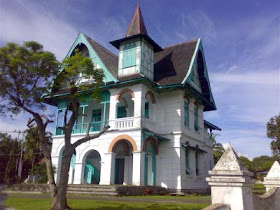Tracing Soppeng Tourism Potential: From Bats To Mystery Villa Juliana
Original Naration by Sapriadi Pallawalino, executive summary by darmansjah godjali
Watansoppeng, the capital of Soppeng become one of the unique cities in Indonesia. The town is located in mountainous areas with a cool climate presents its own views. Upon entering the town which is 150 kilometers north of Makassar, the noise and the noisy and distinctive stinging smell of bats or so-called fruit bats, hanging from the trees along the city will welcome your arrival.
Thus, no one if Soppeng city synonymous with the title of Bats. But not only that, the district with an area of 1359.44 sq km, also promised a number of natural and cultural attractions of interest.
The presence of bats in Watansoppeng, for the local community rather than coincidence. Although the beginning of the existence of these nocturnal animals adorn the trees along the city not exactly known, but local estimates are bats, bats have been around for tens, even hundreds of years. Thus, they believe bats-bats as town guards and conveys news about something good or bad happen in their town.
Moreover, the uniqueness of others are newcomers who urinated on by a gang of bats, was an omen they paired with residents Soppeng
Shower hot LEJJA
Hot water bath is located in the District Marioriawa, located about 44 kilometers from north Watansoppeng. In the bath of this nature, there are three large ponds for bathing, with three different options, hot water, moderate and warm. In addition, there are also five small ponds are equipped with a resting place. Generally, this is for visitors who prefer the VIP.
At the front of one of the main pool, there are also building a house on stilts with spacious interiors that are common for visitors to stay. The atmosphere of a green environment with some leafy trees, making the atmosphere more comfortable.
Natural hot springs that drain the pool Lejja, believed to be efficacious cure various skin diseases, such as itching and treat acne.
NATURAL bath OMPO and citta
Lejja addition, other natural bath contained in Soppeng namely natural bath Ompo and Citta. The difference, on both the bath water is not hot, but cool and clear. Ompo natural bath located in the Village Ompo, District Lalabata, about 3 miles north of the city Watansoppeng, while natural bath located in the village of Citta, Citta District, about 35 miles east of the city Watansoppeng.
Because of the clarity of the water, both natural baths are also a source of clean water through processing into mineral water by a national private company.
Datu Soppeng CASTLE COMPLEX
Not only the rich potential of nature tourism, Soppeng as one of a small kingdom in the past is also loaded with cultural heritage and history. One of them, Datu Soppeng Palace complex is situated in the heart of Watansoppeng. Built around the year 1261 during the reign of King Soppeng, I Latemmamala who holds Bakkae Petta.
In the complex, there are several historic buildings, among other ridi'e balls (yellow house) which became the Kingdom of storage of various types of attributes Soppeng, Salassae Palace which is the former palace of Datu Soppeng, and menhirs Latammapole formerly served as a punishment for people who violated customary way around it seven times.
TOMB Jera LOMPO'E
Jera Lompo'e , which if interpreted in the Indonesian language means the Great Mausoleum, the burial of kings Soppeng, Luwu and Sidenreng in the 17th century. Funeral whose shape is a blend of Hindu and Islamic influences is located in the Bila Village, District Lalabata, or about one kilometer north Watansoppeng.
Another tomb is the tomb complex KalakoE Watu which contained the tomb We Tenri Sui, mother of King Bone Palakka Aru.
Another tomb is the tomb complex KalakoE Watu which contained the tomb We Tenri Sui, mother of King Bone Palakka Aru.
TRADITIONAL HOUSE SAO MARIO
Although not a historical relic, but the custom house that serves as a museum Soppeng District is filled with antiques of high value which is the relics of several kingdoms in Indonesia. Antiques that include a bed, the dining table and chairs, cabinets, hundreds of jars, eating utensils kings, hundreds of sharp weapons in the form of dagger, machete, sword, dagger, and others.
The complex also features a traditional house boat-shaped restaurant pinisi.
VILLA YULIANA
Among the several historical attractions in Soppeng, Yuliana Villa which is one of the Dutch heritage buildings, presents its own mystery. Villa built by C.A. Krosen as governor of the Dutch East Indies government in Sulawesi in 1905, was a twin whose resemble buildings in the Netherlands..
High-rise buildings with construction and architecture of the building which is a blend of European style and Bugis, located directly opposite the Palace complex in the heart of Datu Soppeng Watansoppeng. Villa development is a manifestation of love for Dutch people to Queen Juliana.







No comments:
Post a Comment